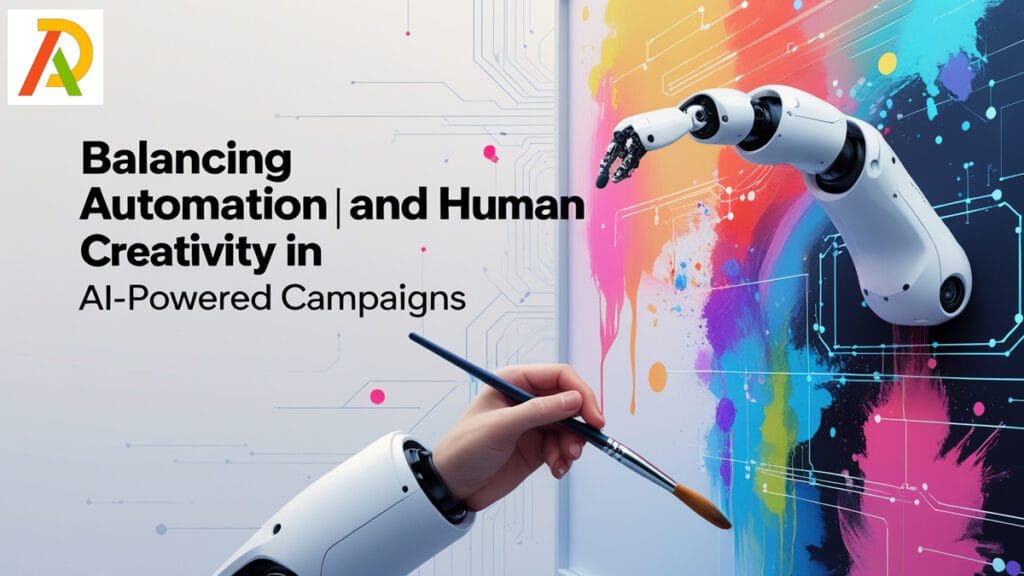Balancing Automation and Human Creativity in AI-Powered Campaigns


Marketing is seemingly moving faster than ever before and a significant part of that is due to AI. Brands can look at customer behavior, run a campaign to acquisition, and deliver personalized messaging at a press of a button. It’s phenomenal, and that is where the catch comes in: just because AI has the capabilities doesn’t mean AI should solely execute marketing. Campaigns without human input, may ultimately feel flat or out of touch.
The real skill lies in knowing when to hand over the project to AI and when human creativity has to take back over. Storytelling, humor, cultural nuance, these are things a machine cannot truly replicate. For marketers, identifying that balance is becoming increasingly important. No matter if its developing an email campaign, or organizing a social media campaign, it is the human perspective that embroiders the whole beautiful picture together.
And if anyone wants to be competitive, they must understand the AI tools at their disposal, alongside a creative digital strategy, this is one of the reasons why signing up for the best digital marketing course can be a game-changing opportunity.
Automation: The Engine Behind Modern Campaigns
Scaling marketing efforts without automation is virtually impossible in today’s world. Take email campaigns for example; manually sending individualized messages to thousands of customers would take weeks. Automation allows brands to connect with the right person at the right time. Starbucks has mastered this, for instance, by sending offers based on previous purchases so that although it appears that each message is tailored specifically for that customer, there isn’t a single person adding it individually.
Automation also makes testing and recommendations much easier. Netflix, for example, trials different versions of its landing pages or trailers and has the ability to immediately recognize the ones that resulted in the most viewer response so they automatically highlight those in their campaign. This testing ensures that brands are constantly relevant with campaigns and helps create a better understanding of how they are resonating with their customers.
Predictive insights are yet another area where automation shines. Amazon looks at buying patterns, trends, and even what customers may want next, or that seem intuitive. This provides companies with insights to stay ahead of customer expectation without having to continuously read and digest.
The point is simple: automation escalates repetitive and time-consuming tasks so that marketers have the opportunity to concentrate efforts on strategic foresight and creative projects. Enable then only troubleshoots the path it is to take, the engine accelerates the direction, while what is lacking comes from us.
Human Creativity: The Soul of Storytelling
No matter how sophisticated automation becomes, it ultimately cannot match the human prowess for crafting compelling narratives. Campaigns which instil a true sense of feeling or emotion, whether joy or nostalgia, or even inspiration regarding a particular value proposition, are those that people remember. However, Apple is a perfect example that not only demonstrates the behaviours of how to properly present features, but also to demonstrate the importance products have in people’s lives, and moments, feeling both authentic and organic.
Likewise, people grasp culture, context, and nuance in ways a machine never will, and the same campaign could be both successful in one market and minuscule in another, if the original campaigns are not grounded in the local cultures or current trends. Nike does a good job of this by designing campaigns that capture and reflect social issues or local interests, which allows their messaging to feel real and relevant, regardless of where it is appearing.
A brand’s voice and authenticity depend on the humanity behind it. AI tools can certainly create technically sound content, but if the voice is out of sync with a company’s values, it will still feel like a misalignment of brand. Humans ensure voice consistency of shape content to align with brand identity and convey the intended message to the audience.
Storytelling is what gives marketing its heart. The machines can do the mechanics. But humans have the creativity, empathy, and judgment. Without these, campaigns will still feel empty, no matter how advanced the technology is.
Case Studies: Brands Getting It Right
Coca-Cola
Holiday campaigns are a great example of how data and the right creative can come together. Coca-Cola used AI to look at what their customer’s were searching for and popular trends. However, they did not simply follow the data. The marketing team took it and shaped a final message that felt heartfelt and personal. People didn’t just see an advertisement, they felt the warmth and nostalgia that the brand wanted to evoke.
Nike
Besides recommending products, the Nike approach goes further. Their artificial intelligence program recommends items based on what customers are interested in, but this is only one element. They couple it with storytelling that reflects local culture and social movements. When they run a campaign linked to a cause or athlete that people care about, it feels authentic and motivating, not like a sales push.
Ralph Lauren

Ralph Lauren has an “Ask Ralph” tool which assists customers to select outfits. While it may seem like customizing selections based on popular trends, advice is tailored to create an elegant classic style created by the brand. Consumers feel like they are receiving intimate clerical advice from someone who understands the essence of the brand rather than product suggestions from a computer.
These examples demonstrate that AI can scrape content, but it’s the human element in the delivery that allows marketing to feel relevant. Campaigns can certainly be created based on creativity and insight, it is a risk to not ensure they don’t fall flat, no matter how cool the technology may be.
Source: https://martech360.com/martech-insights/ai-vs-human-creativity-in-marketing-who-does-it-better/
Pitfalls of Over-Automation
Loss of Authenticity
With everything being automated, messages start sounding alike. It’s as if we are decoding a template as opposed to hearing from a real person. People will pick up on this if it does not feel real. If the story has no heart, they will scroll past immediately.
Consumer Backlash
Some campaigns have faced backlash for being too robotic. Coca-Cola’s overarching holiday campaign is a perfect example. Their holiday campaign did not resonate with their audience. It felt staged and lacked the festive spirit people were looking forward to, which created a barrier between the brand and its customers.
Brand Disconnect
Automation can also lead to missing cultural cues and emotional signals. A joke could be funny one time, and offensive the next; human eyes are needed on the final message. When brands put out campaigns that are offensive or feel wrong due to automated content (e.g., a social media manager publishing automated prompts), they lose credibility as they run the risk of pushing out content that does not feel relatable or on-brand. Humans help to navigate campaigns in the right direction and to keep messaging where it needs to be.
Conclusion: The Future of Marketing
The future of marketing isn’t about choosing between AI and human creativity, it’s about bringing them together. Automation helps with data and efficiency, but it’s the human touch that makes campaigns feel real and relatable. Brands that blend both will stand out with campaigns that are not only smart but also emotionally engaging. For anyone looking to build these skills, joining the top digital marketing course in mumbai can help you learn how to use technology while staying true to creative storytelling. That’s where the next generation of marketers is headed.
Author Bio:
Nikita is a digital marketing professional at BIA. With a passion for emerging industry trends, she enjoys crafting strategies that resonate—and unwinds by diving into fiction novels during her downtime.



